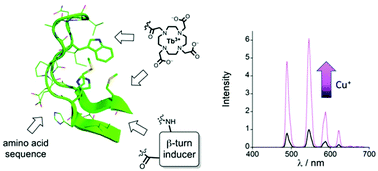Influence of amino acid sequence in a peptidic Cu+-responsive luminescent probe inspired by the copper chaperone CusF†
Abstract
Copper(I) is a soft metal ion that plays an essential role in living organisms and Cu+-responsive probes are required to detect Cu+ ions in physiological conditions and understand its homeostasis as well as the diseases associated with its misregulation. In this article, we describe a series of cyclic peptides, which are structurally related to the copper chaperone CusF, and that behave as Cu+-repsonsive probes. These peptide probes comprise the 16-amino acid loop of CusF cyclized by a β-turn inducer dipeptide and functionalized by a Tb3+ complex for its luminescence properties. The mechanism of luminescence enhancement relies on the modulation of the antenna effect between a tryptophan residue and the Tb3+ ion within the probe when Cu+ forms a cation–π interaction with the tryptophan. Here, we investigate the influence of the amino acid sequence of these cyclic peptides on the copper-induced modulation of Tb3+ emission and show that the rigid β-turn inducer Aib-D-Pro and insertion of the Tb3+ complex close to its tryptophan antenna are required to obtain turn-on Cu+ responsive probes. We also show that the amino acid sequence, especially the number and position of proline residues has a significant impact on metal-induced luminescence enhancement and metal-binding constant of the probes.



 Please wait while we load your content...
Please wait while we load your content...